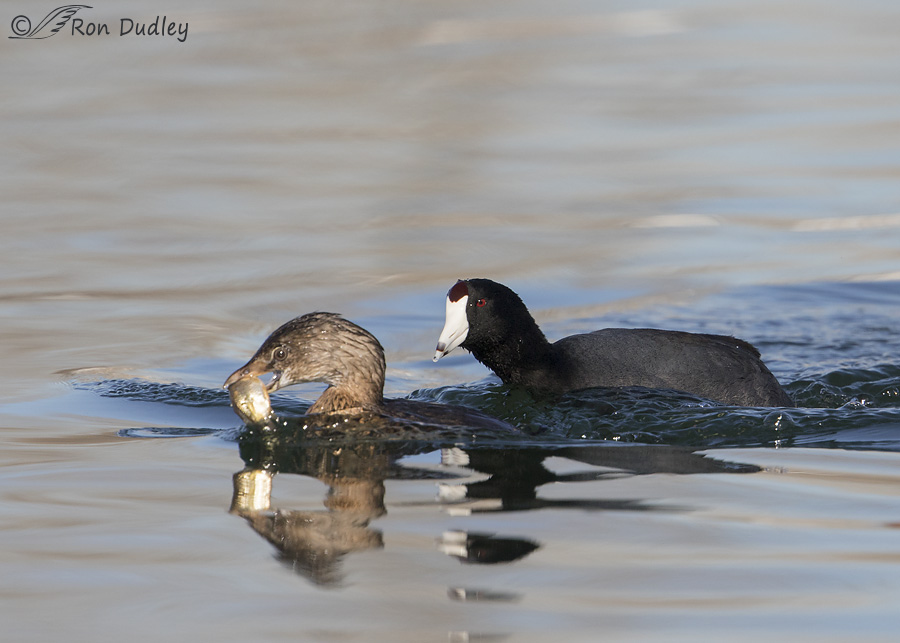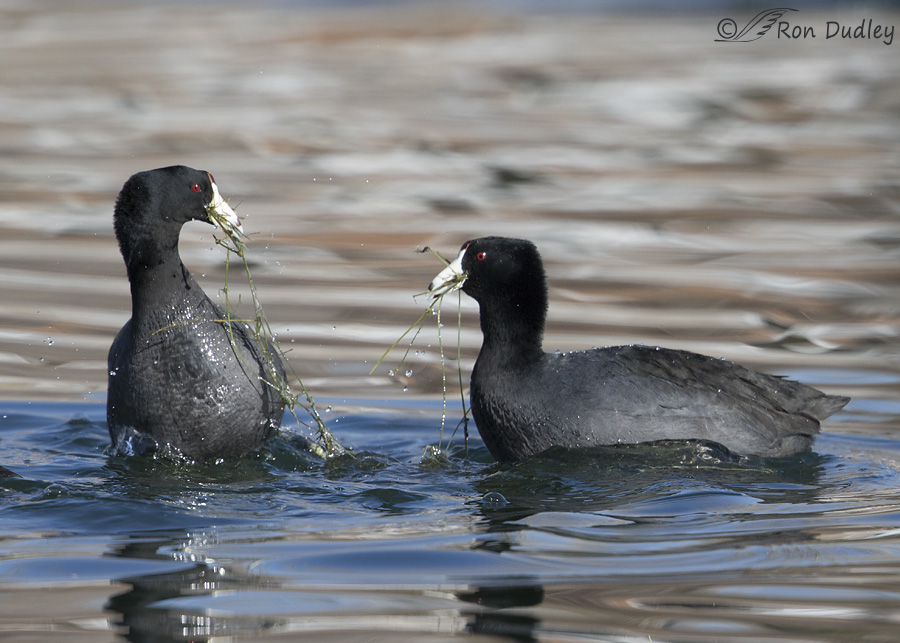American Coots are raucous and quarrelsome birds that can be counted on to stick their noses into everybody else’s business. That personality trait provides countless interesting opportunities for the photographer who’s prepared to take advantage of them.
Each of these images was taken two days ago at a pond near my home.
 1/2500, f/6.3, ISO 500, Canon 7D Mark II, Canon EF 500mm f/4L IS II USM + EF 1.4 III Extender, not baited, set up or called in
1/2500, f/6.3, ISO 500, Canon 7D Mark II, Canon EF 500mm f/4L IS II USM + EF 1.4 III Extender, not baited, set up or called in
Coots are enthusiastic kleptoparasites and will take every opportunity to steal food from their own and other species, even if that food isn’t typically part of their diet. Though they’re primarily herbivores and don’t often eat fish they will if given the chance (I’ve photographed them eating fish several times) – especially if they can steal it from its rightful owner.
When this Pied-billed Grebe surfaced with a small fish the coot rushed in immediately to see if it could take advantage of the situation. It almost rode on the back of the grebe as the smaller but much quicker bird tried to down the fish before it had to fight for it or flee with it. In this case the grebe successfully swallowed the fish but the coot was fully prepared to snatch it away if the opportunity presented itself.

1/2500, f/6.3, ISO 500, Canon 7D Mark II, Canon EF 500mm f/4L IS II USM + EF 1.4 III Extender, not baited, set up or called in
A few minutes earlier the coot on the right who already had a beak-full of food decided that one of its nearby buddies had even more of it and it might be worth stealing so it moved in to attempt exactly that. I fired my shutter just as the coot on the left reacted to the intrusion and began to make its getaway. For me the fact that both birds have food and the reaction of the coot on the left make this photo an interesting one – the poses and the eye contact between them make the tension between the birds almost palpable.
For me it’s the pugnacious nature of American Coots that makes them such an interesting photo subject. Cornell’s Birds of North America Online puts it this way:
- “Universally described as a quarrelsome and belligerent bird, more than ready, willing, and able to engage in either ritualized or outright physical conflict with its own or other avian species.”
The photographer who looks down his/her nose at coots and ignores them because they’re so common (or for any other reason) misses out.
Ron


May I add a rehabilitator’s tidbit? They have very painful bites. You’ve got this thing wrapped in a towel, trying to help it survive, when suddenly the long snaky neck comes flying out, and *&^% it bites AGAIN. They pinch just with the tip of the beak and then twist and won’t let go. Ouch, ouch, G-D bird! Get the thing off, get it all wrapped up again, think you have the head secured, when suddenly here comes the beak again, and whang, it’s got you again. Moments like that can drive the most kind-hearted to want to grab it by the neck an fling it against the wall. I strongly recommend appreciating Coots at a distance.
Interesting info about their bites, Mikal. That’s an experience I hope to avoid!
Great shots! I really enjoy the second one.
I explained why I love coots so much in the comments of yesterdays post, so I won’t bother doing so on todays.
I remembered what you said while I was composing my text, Levi. For that reason I hoped you’d see this post.
Personally, I HATE it when folks use the word common in description/naming of ANY critter! That word has SO much negative baggage it just shouldn’t be used with living things!
I love coots…and thievery is a time-honored strategy for a lot of things. Some people frown on it, but for those who get away with it, it works like a charm! 🙂
“Personally, I HATE it when folks use the word common in description/naming of ANY critter! That word has SO much negative baggage it just shouldn’t be used with living things!”
You and I have had this discussion before, Laura. You hate it but I don’t. Personally I have no problem with it and I will continue to use it on my blog when I think it’s appropriate. To me it’s often the best word for the situation and it has no negative connotation in this context. In fact, I think it’s a badge of honor of sorts since the species, whatever it might be, has (by definition when used currently and not in a common name) thrived, despite the challenges imposed by man on virtually all native wildlife.
Field guides use the term, as do virtually all nature organizations, avian references and birding groups (including falconry organizations) and they obviously don’t think their use of the word reflects negatively on the species involved. I don’t either.
In fact, and as you mentioned, many birds have the word “common” built into their name which makes the word pretty hard to avoid – Common Goldeneye and Common Merganser are examples but there are many others. I certainly don’t think any denigration or disrespect was intended when they were named and I don’t believe using those names is disrespectful to the species.
So it looks like you and I will just have to agree to disagree.
In the second picture, the coot on the right looks to have a very flat head. Is this normal or is there some kind of cranial thing happening? May be that’s what affects their personalities! But Ron, you have definitely caught some uniqueness in that shot. Personality is there. It’s a great shot of something called common!
Depending on the angle I often see that flat head in coots, Dianne.
Coots have round heads the “hackles” are up on both birds giving them a flatish look to the heads.
Thanks for that info, April. I often wondered why I’d sometimes see that “flattop” but usually I wouldn’t.
Big smiles. We all know some coots, and some of them have a place in our hearts.
Yup, coots of a different feather…
Quite a few coots are being appointed…apparently many species have versions of them….
🙂
We have many coots in our neighborhood — feathered and otherwise. I agree that some can be real jerks at times. 😉
Glad the grebe got to keep its lunch. Not always the case for our neighborhood mallards, dogs and cats.
Marty, I guess at my age I’m one of the “otherwise” kind of old coot but I wear the badge proudly! 🙂
But you’re definitely NOT a jerk! 🙂
I enjoy seeing Coots (we get them at Hueco Tanks when one of the areas in the park floods). I’ve not gotten to see behaviors like what you show, though. Mostly they seem to be far away and swimming when I see them. In the second shot, the facial expression/body language of the about-to-be-victim looks almost human.
“the facial expression/body language of the about-to-be-victim looks almost human”
Susan, and to think that some folks don’t give birds much credit for having personalities…
Coots are cool! On a recent trip to Arizona, I saw more coots than I ever imagined. We get them here in New England but not in those numbers. And I absolutely adore their feet – I took lots of photos! At the same time, I never saw the behaviors you describe – my coots were grazing peacefully on large lawns or swimming in ponds. Your photos are enlightening, the second one is especially engaging.
You’re right, Nancy – their unique feet and toes are attention-getters!
Cool! I didn’t know much about them other than Duck Hunters tend to dislike them. 🙂 Glad the Grebe got it’s meal! 🙂
Judy, it’s my understanding that many hunters refer to coots as “mud hens”, at least in part because they taste like mud…
I’d forgotten about that! 🙂
Very interesting and entertaining. It does shed light on why certain old codgers were referred to as ‘old coots’. And I had to smile to learn that there are not in Eastern Canada. Maybe they’re not polite enough to be Canadians – at least in the East? 🙂
Alison, if politeness were a qualifier for residence there, coots would be out of luck. I can’t think of a less “polite” bird…
So that is where the term “the old Coot” comes from? and means?
I don’t know, Thomas. Maybe…
Wonderful captures of these fascinating birds. We don’t see them in Eastern Canada unfortunately. Thank you again for sharing!
Cindy – I learned something from your comment – that they’re not found in eastern Canada. They’re so ubiquitous in most of North America I just assumed they were found there too – an assumption I shouldn’t have made. I just looked at their range map and you’re right!